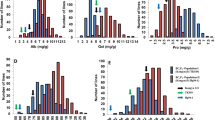Abstract
Protein content (PC) is an important component of rice nutritional quality. In order to better understand the genetic basis of this trait and increase related breeding efficiency, 21 single chromosome segment substitution (SCSS) lines grown in four sites over two growing seasons (regarded as eight environments) were used to associate PC with particular chromosome segments. Segments from 15 chromosomes were found to contain quantitative trait loci (QTLs) for PC in at least one environment. These included segments from chromosome 3 and 8, in which QTLs for PC had not previously been identified. The segment of chromosome 8 in CSSL-48 had the largest positive effect across all environments. The interaction between substitution and environment was highly significant. Some substitutions had large effects in one environment, but no effect in another (i.e. CSSL-08 and CSSL-17), while some substitutions significantly increased PC in one environment but decreased it in another (i.e. CSSL-41 and CSSL-43). By biplot and clustering analysis, the eight environments were grouped into two contrasting environment types, that is, Hainan and Jiangsu. The segment of chromosome 8 in CSSL-48 had PC-enhancing QTLs in both of the environment types. The segments in CSSL-34 had QTLs which increase PC in the Jiangsu environment but have no effect in the Hainan environment. For enhancing PC, CSSL-48 could be explored in breeding for wide adaptation across all environments, while CSSL-12, CSSL-14, CSSL-17, CSSL-41 and CSSL-43, and that in CSSL-34 could be explored in breeding for specific adaptation to the Hainan and Jiangsu environments, respectively. Near isogenic lines are under development to validate the QTLs with large effects in a range of genetic backgrounds relevant to Jiangsu and Hainan breeding programs. Secondary mapping populations are also being developed for further localising the responsible QTLs in CSSL-14, CSSL-34 and CSSL-48.





Similar content being viewed by others
References
Aluko G, Martinez C, Tohme J, Castano C, Bergman C, Oard JH (2004) QTL mapping of grain quality traits from the interspecific cross Oryza sativa × O. glaberrima. Theor Appl Genet 109:630–639
Bartlett MS (1937) Properties of sufficiency and statistical tests. Proc R Stat Soc Ser A 160:268–282
Dunnett CW (1964) New tables for multiple comparisons with a control. Biometrics 20:482–491
Eshed Y, Zamir D (1995) An introgression line population of Lycopersicon pennellii in the cultivated tomato enables the identification and fine mapping of yield-associated QTL. Genetics 141:1147–1162
Frary AN, Nesbitt TC, Frary AM, Grandillo S, Knaap EVD, Cong B, Liu JP, Meller J, Elber R, Alpert KB, Tanksley SD (2000) fw2.2: a quantitative trait locus key to the evolution of tomato fruit size. Science 289:85–88
Gabriel KR (1971) The bi-plot-graphical display of matrices with application to principal component analysis. Biometrika 58:453–467
Howell PM, Marshall DF, Lydiate DJ (1996) Towards developing intervarietal substitution lines in Brassica napus using marker-assisted selection. Genome 39:348–358
Hu ZL, Li P, Zhou MQ, Zhang ZH, Wang LX, Zhu LH, Zhu YG (2004) Mapping of quantitative trait loci (QTLs) for rice protein and fat content using doubled haploid lines. Euphytica 135:47–54
Kempton RA (1984) The use of bi-plots in interpreting variety by environment interactions. J Agric Sci 103:123–135
Kubo T, Aida Y, Nakamura K, Tsunematsu H, Doi K, Yoshimura A (2002) Reciprocal chromosome segment substitution series derived from Japonica and Indica cross of rice (Oryza sativa L.). Breed Sci 52:319–325
Lin HX, Yamamoto T, Sasaki T, Yano M (2000) Characterization and detection of epistatic interactions of 3 QTLs, Hd-1, Hd-2 and Hd-3, controlling heading date of rice using nearly isogenic lines. Theor Appl Genet 101:1021–1028
Nadeau JH, Singer JB, Matin A, Lander ES (2000) Analysing complex genetic traits with chromosome substitution strains. Nat Genet 24:221–225
Perez CM, Juliano BO, Alcantara JM, Cassman KG (1996) Effects of late nitrogen fertilization application on head rice yield, protein content and grain quality of rice. Cereal Chem 73:556–560
Shenoy VV, Seshu DV, Sachan JKS (1991) Inheritance of protein per grain in rice. Indian J Genet 52:214–220
Shi CH, Zhu J, Yang XE, Yu YG, Wu J (1999) Genetic analysis for protein content in indica rice. Euphytica 107:135–140
Shimodaira H (2004) Approximately unbiased tests of regions using multistep-multiscale bootstrap resampling. Ann Stat 32:2616–2641
Tan YF, Sun M, Xing YZ, Hua JP, Sun XL, Zhang QF, Corke H (2001) Mapping quantitative trail loci for milling quality, protein content and color characteristics of rice using a recombinant inbred line population derived from an elite rice hybrid. Theor Appl Genet 103:1037–1045
R Development Core Team (2008) R: a language and environment for statistical computing. R Foundation for Statistical Computing, Vienna, Austria. ISBN 3-900051-07-0. http://www.R-project.org
Tsunematsu H, Yoshimura A, Harushima Y, Nagamura Y, Kurata N, Yano M, Sasaki T, Iwata N (1996) RFLP framework map using recombinant inbred lines in rice. Breed Sci 46:279–284
Wan XY, Wan JM, Su CC, Wang CM, Shen WB, Li JM, Wang HL, Jiang L, Liu SJ, Chen LM, Yasui H, Yoshimura A (2004) QTL detection for eating quality of cooked rice in a population of chromosome segment substitution lines. Theor Appl Genet 110:71–79
Ward JH (1963) Hierarchical grouping to optimize an objective function. J Am Stat Assoc 58:236–244
Williams WT (1976) Pattern analysis in agricultural science. Elsevier, Amsterdam
Yan W (2001) GGEBiplot—a Window application for graphical analysis of multi-environment trail data and other types of two-way data. Agron J 93:1111–1118
Yano M, Katayose Y, Ashikari M, Yamanouchi U, Monna L, Fuse T, Baba T, Yamamoto K, Umehara Y, Nagamura Y, Sasaki T (2000) Hd-1, a major photoperiod sensitivity quantitative trait locus in rice, is closely related to the Arabidopsis flowering time gene CONSTANS. Plant cell 12:2473–2483
Ye G, Smith KF (2010) Marker-assisted gene pyramiding for cultivar development. Plant Breed Rev 33:219–256
Author information
Authors and Affiliations
Corresponding author
Additional information
Communicated by M. Cooper.
Rights and permissions
About this article
Cite this article
Ye, G., Liang, S. & Wan, J. QTL mapping of protein content in rice using single chromosome segment substitution lines. Theor Appl Genet 121, 741–750 (2010). https://doi.org/10.1007/s00122-010-1345-2
Received:
Accepted:
Published:
Issue Date:
DOI: https://doi.org/10.1007/s00122-010-1345-2




